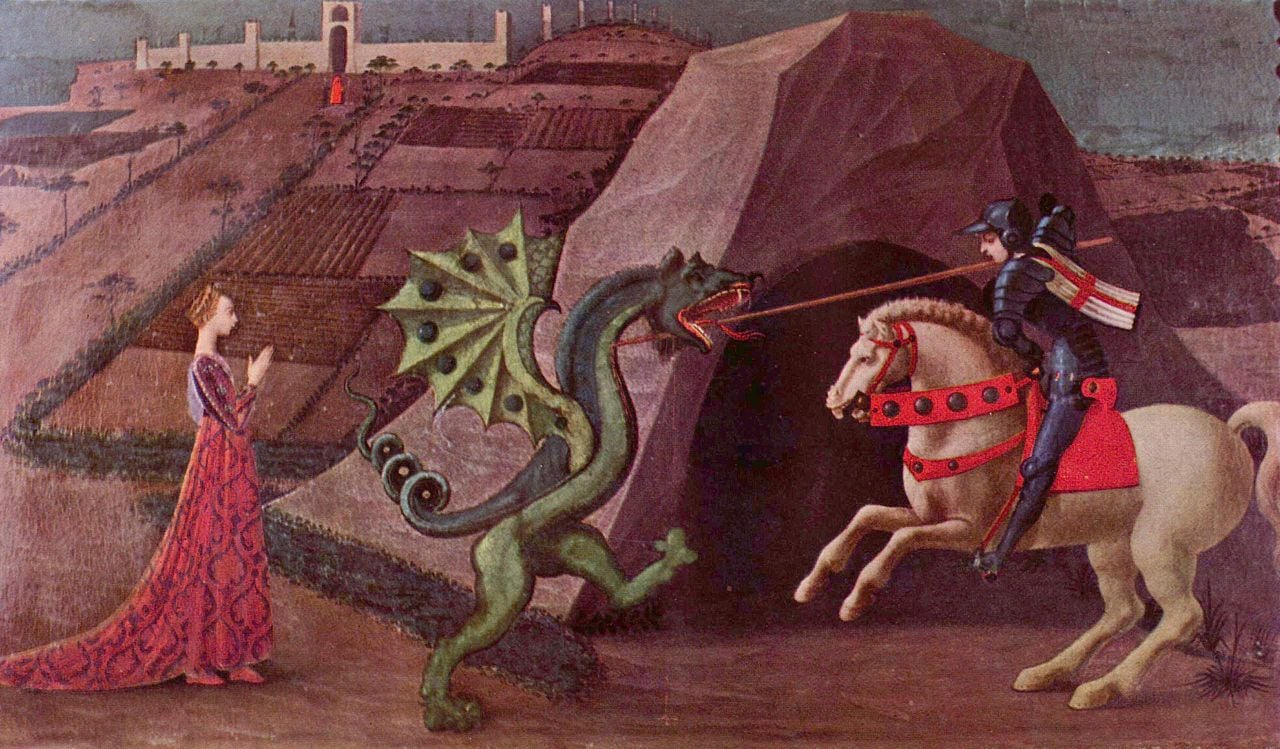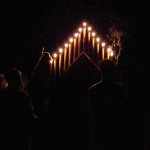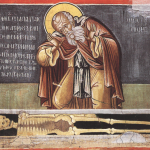[Editor’s Note: Here is a beautiful post focused on one canto in Dante’s Commedia. I love the way this begins. How liturgically appropriate!]
Midway through this Lent, we may find ourselves, like the poet Dante, in the dark wood of sin, laboring to unite both mind and body in our Lenten ascent. In canto V of the Inferno, Dante dramatizes how one sin, lust, violates the communion of persons which is at the center of St. John Paul II’s Theology of the Body. In reading the canto through this lens, the Theology of the Body illuminates how concupiscence dominates the state of man’s soul through the operations of sensuality and sentimentality. In breaking this law of love between persons on earth, the lustful of Dante’s second circle of hell cannot achieve the Trinitarian communion of highest paradise.
The Catechism of the Catholic Church states that concupiscence is the “inclination to evil” (405). The value of concupiscence focuses on the body only, and therefore sexual values usurp personal values which are essential to love. John Paul II asserts that “the state of the soul of the man [is] dominated by concupiscence of the flesh” (TOB 282). He quotes lines from canto V to illustrate concupiscence as the inner break in man and why it is worthy of punishment: “I learned that those who undergo this torment are damned because they sinned within the flesh… There is no hope that ever comforts them—no hope for rest and none for lesser pain” (Dante; as quoted in TOB 283). The souls in the circle of the lustful, by giving way to concupiscence of the flesh, crossed the threshold of hell’s broad and easy gate.
The punishments of the circle emphasize the sensuality of the damned. Dante the pilgrim descends into the circle “designed for the damned who were wicked in the flesh” (Dante 37-8), a place where “all light is struck dumb,” where a “hellish cyclone that can never rest snatches the spirits up…and buffets them” (28, 31-3). This is the contrapasso (the punishment designed by the Creator specifically to counteract lust) that Dante has matched with these sinners. The sinful acts, which seemed so pleasant on earth, took place in darkness. Now in hell, the darkness is perpetual. The storm that “whips those evil souls, flinging them here and there and up and down” (42-3) represents the wind of the passions that never relents but drives the sinner on to the next insatiable pleasure. John Paul says that “passion aims at satisfaction… it ‘wears itself out'” (TOB 284). He says that the personalistic norm (the confirmation of the person as a being who demands love) is violated when reason is subject to desire, when love is subject to pleasure. The lustful are damned because they did not integrate love with the whole value of the person.
The souls of Paolo and Francesca, arguably the most famous sinners in the Inferno, tell the story of their damnation. Francesca was an Italian woman in a political marriage to a disfigured man. She fell in love with her husband’s brother Paolo who was sent to court her in his brother’s stead. The two were caught and murdered in the adulterous act by Francesca’s husband. The lovers formed a bodily union but failed to integrate the fullness of their personhoods. They are damned together in hell but have no true connection. The lustful are cut off in the darkness, blinded from the mature values that constitute the spousal meaning of the body. In retelling the story of their damnation, Francesca tells of lust which drove her and Paolo to hell: “Love that flames soonest in the gentle heart seized him for that sweet body…” (Dante 100-04). In Love and Responsibility, Karol Wojtyla exhorts that one “distinguish very carefully between whatever shows ‘loving kindness’ and whatever shows not that but the intention to use a person even when it disguises itself as love and seeks to legitimate itself under that name” (34). Francesca tries to legitimate lust as love, and continues to violate the communion of persons by focusing only on bodily pleasures. Paolo and Francesca have detached the body from the person, and are thus damned forever in mock-communion.
It is interesting to note that, in hell, Paolo and Francesca are in a way stripped of their masculinity and femininity, which are vital to the Theology of the Body, co-titled Man and Woman He Created Them. Only once does Francesca call Paolo the “man;” rather, he is often just the body, the other. Paolo, effeminately, never speaks a word; Francesca has taken on the leadership role, and Paolo passively wails beside her. In hell, they are reduced to mere bodies, deprived of the glory and dignity of their genders, because they reduced one another to bodies on earth. Because ‘male’ and ‘female’ are essential to the beatifying spousal union, because the body “manifests the reciprocity and the communion of persons” (TOB 183), it is fitting that Paolo and Francesca have perverted this. Sin has dimmed the reflection of God in their genders.
Though many sinners in this circle of hell are obviously sensual, the story of Paolo and Francesca highlights first sentimentality, which is also an effect of concupiscence. If not properly integrated, sentimentality will direct itself to lust. If it is only the “need to feel emotion for its own sake” (LR 152), it will lead to eroticism and sensual feelings as much as sensuality does. This negation of love shrouded by sentiment is part of Paolo and Francesca’s sin. Sentimental language litters the canto in the descriptions of Paolo and Francesca: “As turtledoves who hear the loving call—with firm and lifted wings they shear the air and fly to the sweet dovecote, swift of will— so did they veer away… through that malignant air” (Dante 82-5). Comparing the lustful lovers to turtledoves is a sentimental simile for a gross offense. Paolo and Francesca’s relationship, which seems as innocent as turtledoves, is exposed for its reality: souls eternally tortured. Dante prepares the reader with these analogies to show that lust is “sensuality concealed and disguised as sentiment” (LR, 111). If love remains mere sentiment, it is the opposite of love. True Love does not beget death, but life to the full.
Francesca retells the moment where sentimentality meets sensuality: “this man…trembled to place his lips upon my mouth” (Dante 135-6). Her sentimental language is like the lines of a romantic poem, similar to the book the lovers were reading–the affair of Lancelot, knight of the Round Table, and Guinevere, King Arthur’s wife. Francesca has made Paolo into her knight, and she is the queen. She has made him into a sentimental character rather than a human being, disillusioned from his real value as a person, for “the values ascribed to the beloved person are fictitious” (LR 113). Sentimentality, for the lovers, “charms and disarms” the will (111), which is where the virtue of love must first form. If love persists as mere sentiment, Wojtyla says, “both persons will remain…divided from each other, though it may appear that they are very close just because they so eagerly seek proximity” (113-14). This is the case with Paolo and Francesca. They appear physically close, even in hell, but their love is plagued by sentimentality and sensuality.
The lustful sinners in Dante’s Inferno show how actions fragmented from a coherent theological anthropology leads to an existence that is hell itself. Both Dante and John Paul II show the reader the centrality that the body plays in the journey to sanctity. The utilitarian aspect of hell is apparent even in this early circle: sin is an inward vortex to satisfy one’s own desire rather than a fountain of self-gift welling up to eternal life. The selfish consumption of the body rather than sacrament of the Body is a mockery of the wedding feast of the Lamb, the banquet of highest heaven, where God is all in all. In Paradise, the beatified saints partake of the Creator who is Love Himself. Only at the heart of such a communion does man find fulfillment in the Love that moves the sun and all the stars.
***
Emma Vinton is a junior studying English at Hillsdale College. She loves classic literature, Catholicism, and all things Dante.














